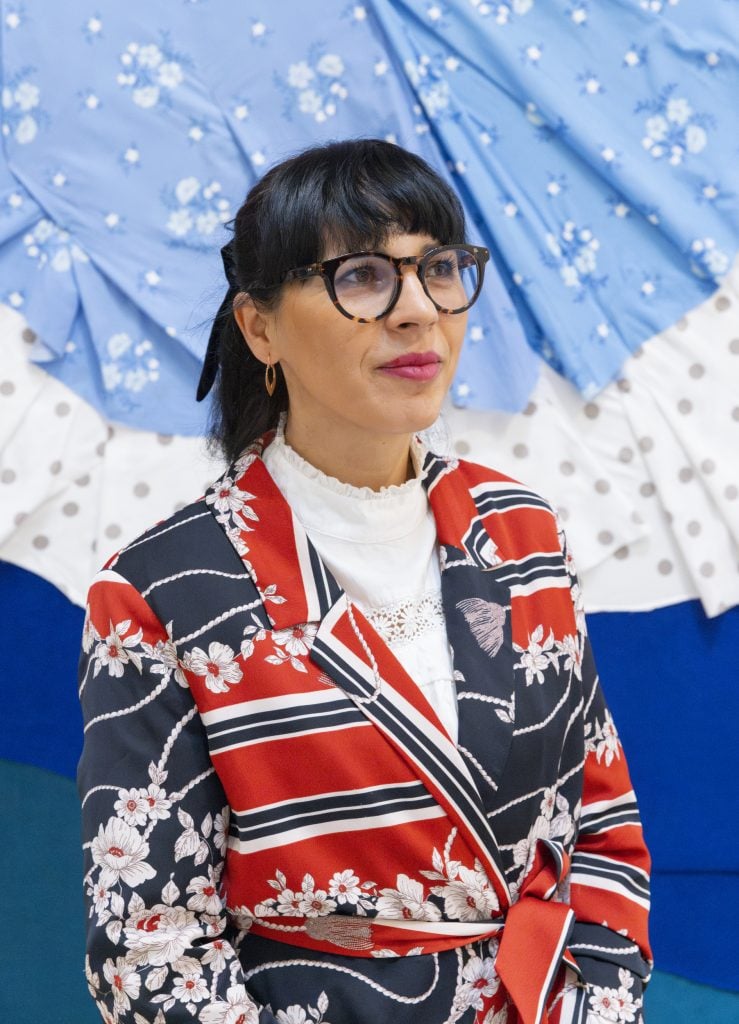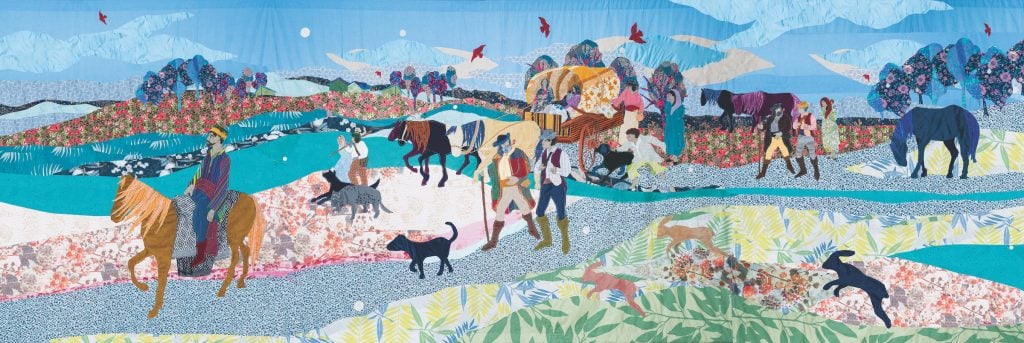
20 Dec Giant Fabric Billboard Celebrating Romani People Lands in New York
Source Credit: Content and images from Artnet News. Read the original article - https://news.artnet.com/art-world/malgorzata-mirga-tas-high-line-2590812
One of the stars of the 2022 Venice Biennale—and the first Roma artist ever to represent a country at one of the exhibition’s national pavilions—Poland’s Małgorzata Mirga-Tas is making her U.S. debut on New York’s High Line.
The artist is known for transforming used clothing into monumental hand-stitched figurative fabric panels celebrating the Romani people. For the High Line, Mirga-Tas has created a billboard featuring a bucolic scene of the Roma on the road, enjoying their traditional itinerant lifestyle.
“This is a special one because it’s an outdoor scene where you see a procession or a caravan of people walking through the landscape,” Cecilia Alemani, High Line Art’s director and chief curator, told me. “I think it fits very well with the High Line and the city of New York. But it is also a departure from the more intimate domestic scenes that she often does of a family around the table having a meal or sharing stories. This is a much more epic depiction of her people.” (Alemani curated the international exhibition at the 2022 biennale, but was not involved in the Polish pavilion featuring Mirga-Tas.)
The work, titled Beyond the Horizon, is the second in the High Line’s revived 18th Street billboard series, which kicked off in September with a work by Glenn Ligon. Originally used for advertising, of course, the billboard was a regular High Line Art venue for the first five years after the park’s opening, but was torn down in 2015 due to construction. Now, the parking lot where it once stood is becoming a public plaza, and the art is back.

Małgorzata Mirga-Tas at Tate St. Ives, (2024). Photo by Lucy Green, ©Tate.
The piece is also the latest entry in Mirga-Tas’s “On the Journey” series, which reclaims art historical depictions of the Roma by subverting stereotypes portraying them as dangerous and frightening.
“This sort of iconography has not been created by the Roma people, but of course by other people, and so she’s trying to to completely turn it upside down and be more faithful to the joy of her own community,” Alemani said.
To date, most of Mirga-Tas’s career success has come in Europe, including three solo shows this year at the Västerås Konstmuseum in Sweden, the Bonnefanten Museum in Maastricht, and Tate St. Ives in Cornwall. She was also included in Documenta 15 in Kassel, Germany.
“I can imagine that her work would be very well received here,” Alemani said.
On the occasion of the work’s unveiling, I spoke with Mirga-Tas about her first stateside project, how art history informs her work, and how she turns discarded textiles into vibrant works of art.

Małgorzata Mirga-Tas, Beyond the Horizon (2024), adjacent to the High Line on the 18th Street Billboard. Photo by Timothy Schenck, courtesy of the High Line.
Had you ever visited the High Line before you were invited to do this billboard, and what do you think of the park? How does it feel to show in New York?
I never had a chance to visit High Lane, but when I was offered the opportunity to create a project for the billboard, I was really attracted by the idea and the place.
The idea of art in space, of sharing one’s work in a place where everyone can see it, is close to me. The proximity to the park, where whole families somehow mentally take part in this journey, is so symbolic. You have time to reflect and think.
With your first public artwork in North America, do you expect that your work will be viewed through a different lens here? Do you see any parallels between discrimination against and fear of the Roma in Europe and that of migrants in the United States?
In creating my work and choosing the subject that I am currently working on, I was motivated by the need to make visible how the Roma, Sinti, Travellers were historically portrayed: from the 15th century through the 20th century, the Roma image has been shaped in a stereotypical and stigmatizing way. Historically, we can see a similar treatment of other minority groups seen as “the Other,” including in the U.S., for example in how African Americans, Native Americans, or migrants were portrayed.
Through my work I reinterpret these historical images to retell the story of which I am a part. It is an act of artistic reappropriation.
I would like people to learn something about the Roma and Sinti, to take an interest in our community and to listen. After all, there are many Roma living in the U.S. too.

Małgorzata Mirga-Tas, Beyond the Horizon (2024), adjacent to the High Line on the 18th Street Billboard. Image courtesy of the artist.
When did you start the “On the Journey” series and what inspired you to use works from art history to help reclaim representation of the Roma?
I have been working on this series for some time now, I think, since 2019. At the time, I relied on the famous 17th-century series of engravings, “Les Bohemiens” by Jacques Callot, which depict the Roma in a stereotypical way. I decided to change his narrative on Roma and Sinti to reclaim the image of the Roma, reappropriating what has been seized from us and what has stigmatized us through these images for centuries.
Let us remember that until the 20th century, all images about Roma were created by non-Roma, from an external perspective—stereotypical, damaging, often racist. They were and continue to be the basis for anti-Gypsyism.
Searching for similar depictions in museum collections in other countries, I realized that these images of the Roma, regardless of the country, are identical. Despite the difference in time, place, and group, they are all copies of each other. Having regained control over my image and representation, I decided to sew them back together, warm them up, dress them up and imbue them with Roma history.
For me, it is important to work in a certain way, choosing carefully how I reinvent these images and how I talk about them. The lives of the Roma people were not easy, so recreating their journeys does not have to be done in an aura of negative texts, emotions, or fear. Reclaiming our subjectivity is a priority for every human being, to be able to speak for ourselves and decide our future and how we are spoken about. Art helps to reclaim representation and offers opportunities to retell one’s own story and perspective.
What are your first memories of seeing art and how did you decide to go to art school?
My first memories are of sculpture, liking gluing and chiseling something. I was drawing and sketching, and I don’t think I thought about art school at the time. It was only at the age of 15 that I decided to go to art school. I couldn’t imagine any other place for myself. To tell you the truth, my mother didn’t see me anywhere else either. But sculpture has always been close to me, so I decided to study sculpture at the Academy of Fine Arts in Krakow.

Małgorzata Mirga-Tas, Beyond the Horizon (2024), adjacent to the High Line on the 18th Street Billboard. Photo by Timothy Schenck, courtesy of the High Line.
Did you learn to sew from your family members?
I don’t think it was our tradition to sew, but surely manual skills helped. My mother told me that after the war my grandmother sewed all her clothes by hand, and later also for her children. This was due to the lack of money for a wardrobe during the difficult communist times. If she had fabric or used clothes, she could alter or sew something herself.
I also remember the gatherings of all the women in our family who worked together to do things (me, my sister, and my cousins were small), such as peeling feathers for pillows or sewing duvet covers or pillowcases, with frills and lace. Such memories of collective work always stay in my mind.
How big is the team who helps you sew today? Are many of them family members?
Since the start of the project “Re-enchanting the World,” I have been working regularly with three assistants: Halina Bednarz, Gosia Brońska, and my aunt Stasisława Mirga. Of course, I can also count on the support of my whole family, especially the women in my family: my mum, my aunts, my cousins, my sister, and so on, to carry out projects for the Roma community. Sometimes I also work with friends from Roma organizations. It depends on the project.
“Małgorzata Mirga-Tas, Beyond the Horizon: A High Line Billboard” is on view adjacent to the High Line at 10th Avenue and 18th Street, New York, December 13, 2024–February 2025.
Source Credit: Content and images from Artnet News. Read the original article - https://news.artnet.com/art-world/malgorzata-mirga-tas-high-line-2590812

